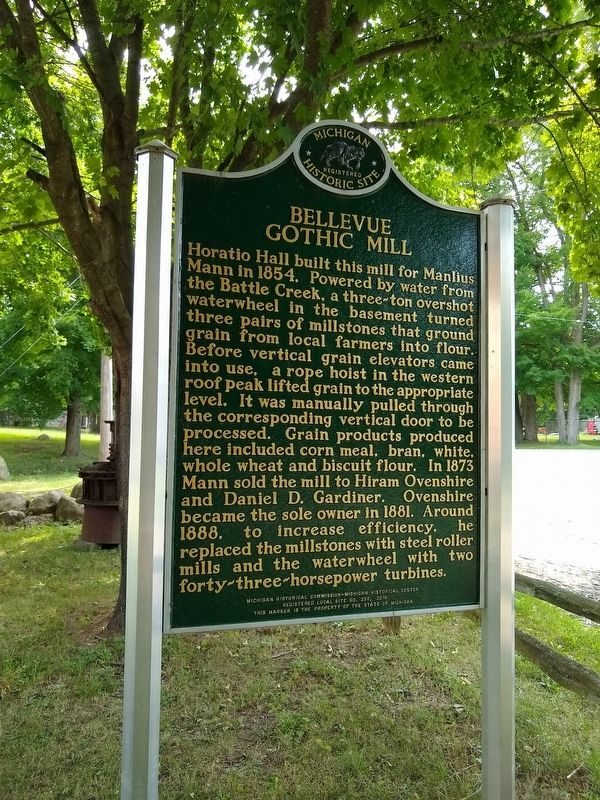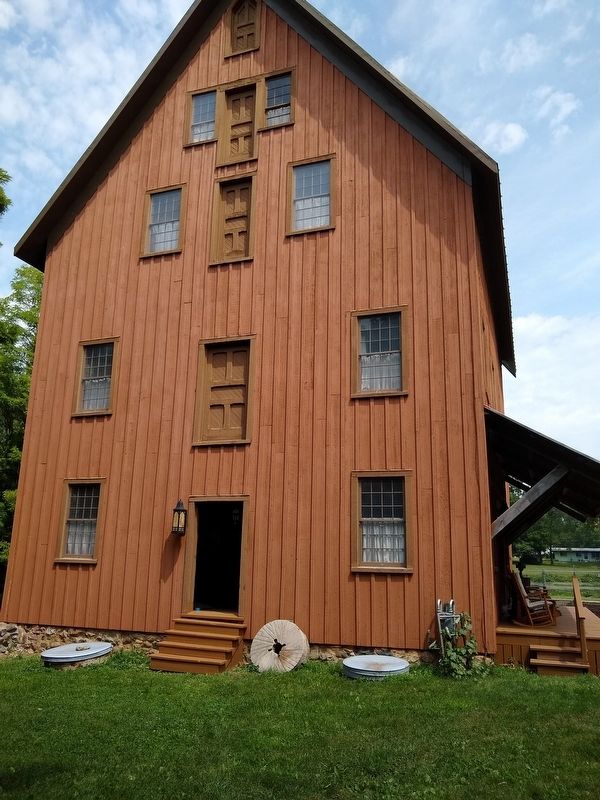Bellevue in Eaton County, Michigan — The American Midwest (Great Lakes)
Bellevue Gothic Mill
Horatio Hall built this mill for Manlius Mann in 1854. Powered by water from the Battle Creek, a three-town overshot waterwheel in the basement turned three pairs of millstones that ground grain from local farmers into flour. Before vertical grain elevators came into use, a rope hoist in the western roof peak lifted grain to the appropriate level. It was manually pulled through the corresponding vertical door to be processed. Grain products produced here include corn meal, bran, white, whole wheat and biscuit flour. In 1873 Mann sold the mill to Hiram Ovenshire and Daniel D. Gardiner. Overshire became the sole owner in 1881. Around 1888, to increase efficiency, he replaced the millstones with steel roller mills and the waterwheel with two forty-three horsepower turbines.
Back Side
The Bellevue Gothic Mill produced many flour products and brands, including Blue Bird flour, marketed by Abram Butler, a former dry goods store owner. By 1929 the mill yielded up to sixty barrels of Blue Bird flour per day. In 1949 this was
the only mill within a fifty-mile radius that still produced flour. Hiram Ovenshire’s descendants, whose surnames included Ovenshire, Hollenbeck and Butler, owned the mill until it closed in 1958.
It was listed in the National Register of Historic Places in 1975. In 1977 the
Stockhausen family purchased the property. They restored the exterior and renovated the interior for an adaptive reuse as a private residence. In 1982 they installed two hydroelectric generators in the basement, allowing them to supply renewable power to the community.Erected 2016 by Michigan Historical Commission - Michigan Historical Society. (Marker Number L0257.)
Topics and series. This historical marker is listed in these topic lists: Industry & Commerce • Waterways & Vessels. In addition, it is included in the Michigan Historical Commission series list. A significant historical year for this entry is 1854.
Location. 42° 26.767′ N, 85° 1′ W. Marker is in Bellevue, Michigan, in Eaton County. Marker is on Tanners Alley near East Mill Street, on the right when traveling north. Touch for map. Marker is at or near this postal address: 218 E Mill St, Bellevue MI 49021, United States of America. Touch for directions.
Other nearby markers. At least 8 other markers are within 8 miles of this marker, measured as the crow flies. Olivet College (approx. 4.7 miles away); Olivet College World War I Memorial (approx. 4.7 miles away); First Congregational Church (approx. 4.8 miles away); Walton Township World War I Memorial (approx. 4.8 miles away); Walton Township Veterans Memorial (approx. 4.8 miles away); The Hawkins Farm (approx. 6.9 miles away); Stow-Hasbrouck House (approx. 7.3 miles away); Bryant Farm (approx. 8 miles away).
Regarding Bellevue Gothic Mill. In 1832, Isaac Crary first purchased the land on which he would later plat the village of Bellevue, choosing it in part for the easy access to water power. He soon constructed the first mill in Bellevue. In 1852, Manlius Mann, from Marshall, Michigan, purchased this plot of land. He hired builder Horatio Hall to construct this gristmill as well as a sawmill. Mann continued to run the mill until 1873, when he sold it to Hiram Ovenshire and Daniel D. Gardiner. In 1881, Ovenshire bought out his partner and became the sole proprietor. Ovenshire passed the mill down to his descendants, including A.G. Butler in 1923. The Butler family ran the mill until 1958, when mill operations ceased.
After closure, the mill was used for grain storage until 1975. In 1977, the Stockhausen family purchased the property, restored the exterior, and renovated the interior for use as a private residence. The mill is occasionally open for tours.
The Bellevue Gothic Mill is a three-and-one-half-story structure measuring 25 feet wide and 40 feet long, and sitting on a rubble foundation and with a gabled sheet metal roof. It is clad with a combination of tongue and groove siding and vertical board and batten siding. It is constructed from massive twelve by twelve walnut timbers and three by twelve floor joists. A loading dock was once connected to the mill but has now been removed
Also see . . . Michigan SP Bellevue Mill. National Register of Historic Places Nomination Form <blockquote> When in 1832 Isaac E. Crary bought the land upon which he later platted the Village of Bellevue, he chose the site not only for its openness and beauty, but particularly for its water power. The Battle Creek River flowed through Bellevue on its way to the City of Battle Creek where it emptied into the Kalamazoo River. (Submitted on January 14, 2021, by Thomas Fehring of Whitefish Bay, Wisconsin.)
Additional keywords. grist
Credits. This page was last revised on February 6, 2021. It was originally submitted on January 14, 2021, by Thomas Fehring of Whitefish Bay, Wisconsin. This page has been viewed 280 times since then and 28 times this year. Last updated on February 5, 2021, by Thomas Fehring of Whitefish Bay, Wisconsin. Photos: 1, 2. submitted on January 14, 2021, by Thomas Fehring of Whitefish Bay, Wisconsin. • Mark Hilton was the editor who published this page.
Editor’s want-list for this marker. Photo of the back side of marker. • Can you help?

